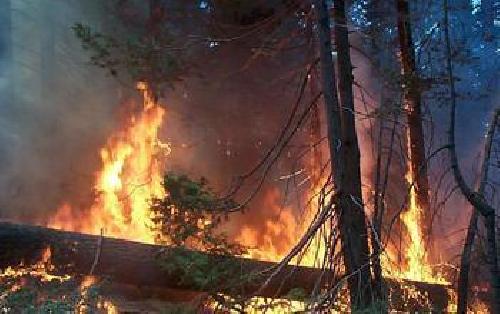Forests nationwide are feeling the heat from increasing drought and climate change, according to a new study by scientists from 14 research institutions.
"Over the last two decades, warming temperatures and variable precipitation have increased the severity of forest droughts across much of the continental United States," said James Clark, lead author of the study and an environmental scientist at Duke University.
Clark and colleagues published their paper today in the journal Global Change Biology.
 Wildfires, with flames fanned by drought, are happening on large scales across the US West. Credit: USGS
Wildfires, with flames fanned by drought, are happening on large scales across the US West. Credit: USGS
"While the effects have been most pronounced in the West, our analysis shows virtually that all U.S. forests are now experiencing change and are vulnerable to future declines," Clark said.
It's a tall order to predict what these forests will look like in 20 years, the researchers say.
Drought across the U.S. West
Drought-induced forest diebacks (the deaths of entire communities of trees known as stands), bark beetle infestations, and wildfires are already occurring on large scales across the West. Many models predict droughts are likely to become more severe, frequent and prolonged across much of the U.S.
Evidence is also mounting that climate is changing faster than tree populations can respond.
As conditions become drier and warmer, many tree populations, especially those in Eastern forests, may not be able to expand into new, more favorable habitats, fast enough to keep up.
"Most forest research is carried out at local study sites, where trees are individually catalogued and measured," said Henry Gholz, a program director in the Division of Environmental Biology at the National Science Foundation (NSF), which supported the research. "This approach risks 'missing the forest for the trees.'"
The new results show that changes in both western and eastern U.S. forests could happen quickly under drier conditions in the future, said Gholz.
"Prolonged drought affects wildfire risks, species distribution, forest biodiversity and productivity, and virtually all goods and services provided by forests," Clark said, "so there is a pressing need to know what is happening now, what might happen in the future, and how we can manage for these changes."
Forests and drought, from A to Z
The new paper addresses this need by providing a comprehensive overview of current and projected drought effects on forests nationwide, how they vary by region, and which management practices could help to partially mitigate adverse effects.
The paper also identifies critical gaps in our knowledge base that hinder scientists' ability to predict the pace and extent of future drought effects on forests.
"We currently have a pretty good handle on predicting the impacts of climate change and drought on individual trees," Clark said. "Ecologists have identified many of the important differences between species that explain how they respond differently to drought."
But, he said, uncertainty still exists about what might happen at the species-wide or stand-wide levels, particularly in Eastern forests. "These are the scales where we really need reliable predictions so forest managers can take steps now to help reduce large-scale adverse future effects."
Without a stronger basis for understanding how the complex interactions among trees, species and environmental conditions work at broader scales, even the most sophisticated current models can provide only limited guidance, Clark said. "That's where we need to focus our efforts now."
source: National Science Foundation